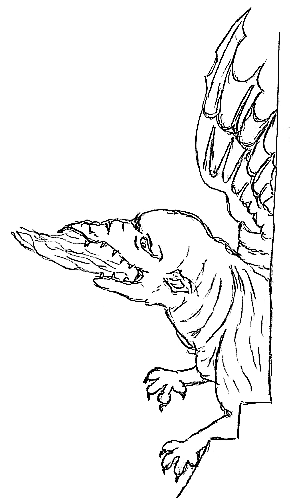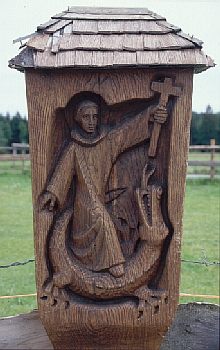 | ||||||
St. MagnusSt. Magnus war a monk of the monastery St. Gallen (Switzerland). About his life we know only few reliable data. Too much has been distorted in later legends. Some say that he was born around 700 AD and died on September, 6th 772. According to others 750 was the year of his death. Neither do we know anything about his nationality. The "official" Vita St. Magni claims that he was Irish, but several historical facts oppose that oppinion. He could have been Alemannian, but most probable he was of Romanic descent. Neglecting the miracolous accessories of his Vita we may recognize some historical roots. Together with his companions Tozzo and Theodor, Magnus left St. Gallen to prosylete the heathens of the Allgäu region (Southern Germany). Bregenz, at the eastern shore of Lake Bodan (= the Lake of Constance), he reached first. During his short stay he healed a blind man who accompanied him on his further travels. Later he went to Kempten, then a nearly deserted and (neo-) pagan town. Magnus there restored Christianity and (re-) built a church. Theodor was left there as a priest while Magnus and Tozzo travelled on and soon reached the surroundings of Füssen. A church was built in the nearby village Waltenhofen. Later he founded the (Benedictine) monastery of Füssen where he died after a long life of worship. During his peregrinatio Magnus worked many miracles. He had to fight serpents and dragons both in Kempten and at Rosshaupten near Waltenhofen. Kempten was deserted when Magnus arrived there. No one dared to stay even for one night, for this place was haunted by all kinds of serpents and worms. Magnus neglected his companions´ warnigns and took up his abode right outside the town. Not for long they had kneeled down for prayer when a huge serpent - named Boas - rushed towards them. Tozzo and the formerly blind man climbed a nearby tree to get out of this peril. But Magnus and Theodor awaited the beast making the sign of the cross. Magnus grasped a cross and the holy staff of St. Gallus (who according to the Vita was his teacher).
A local legend reports that Magnus and Tozzo afterwards had a look at the worm´s cave. In front of it they found a tree full of tasty, ripe apples. Around this tree (the only living thing in the desolation of the dragon) Magnus built a monastery. According to the official Vita, however, that apple tree grew some kilometers apart in a place today known as Waltenhofen. There Magnus errected a church (which Tozzo attended as a priest). Soon afterwards he founded the (today Benedictine) monastery at Füssen. It is worth pondering over the name Rosshaupten. Etymologically it is derived from the German words Ross = horse and Haupt = head or skull. A common explanation was that from this point onward the use of horses was impossible. Riders had to leave them behind and proceede on foot. However, it is more probable that the name refers to a pagan sanctuary where horses were offered to the old German god Wodan. A local myth mentions a headless horse rushing down a hill. Halfways it met a beheaded bull running in the opposite direction. After a short fight they trampled each other into the ground, but then suddenly forgot their struggle and ran off where they had come from. Around 1800 peasants gave the following explanation (which is not included in the official Vita of the saint): Magnus once came upon a pagan ceremony in which horses and bulls were offered. He ordered the allready beheaded animals to run off. Thus he convinced the heathens of the powers of the cross. This implies that at the end of the 18th century the sacrification of horses was still part of public perception. During the first half of the ensuing century peasants made other use of dried skulls of horses and bulls. They kept them in the stables to prevent thunderstokes and banish pestilence. Magnus became a very popular saint. Besides Rosshaupten 14 other villages claim to be the location of a dragon fight. In most cases these legends are just plagiarisms of the "official" version. Ronsberg is one of these villages. Its dark woods were terrorized by three atroceous dragons, remnants of a godless, pagan time. Neither man nor cattle they spared. At last a daring man was found who promised to negotiate with the beasts. Using some magic powers he succeeded in making a bargain. The dragons should spare the village and seek their prey elsewhere in the adjacent districts. For a while all went well. But one day the assigned boroughs had been deprived of every living creature, and the dragons turned towards Ronsberg once more. This time the sorcerer had no opportunity to negotiate: He was devoured at once. The next day the peasants offered an old cow. Although it is hard to imagine that only one cow could satiate three dragons, the trick worked: The beasts got tired and fell asleep. A brave messenger was sent out for St. Mang. The holy man had just tamed a tribe of bears (another motive derived from his vita) and tought them to hunt demons. With those strange companions he approached Ronsberg. The bears killed the dragons, Magnus lit the forest and their lairs went ablast. In another, very strange legend Magnus had killed several worms but spared one hatchling because of his innocence. This young dragon was educated at Kierwang and helped the peasants to clear the woodland. He not only cut down the trees but also sawed them into pieces. He carried wood and stone, cleared off the snow and even helped in the construction of new roads. He had just one fault: Hay and straw he despised and never he got satiated by mice and rats alone. So now and then he stole a calf from the pastures. This was too much for the avaricious peasants. They decided to chop him into pieces while he lay asleep. But when the first stroke hit his breast a strong jet of milk issued from the wound. It was the best milk you could think of! The peasants realized that this dragon was gold worth: He gave more milk than all cows of the village together. They begged his pardon - in vain. The dragon felt insulted. He left and was seen never again. Sources:
[ Die Magnus-Ausstellung in Füssen (D) (21. Juli bis 03. Oktober 2000) ]
© MM by J. Georg Friebe |

